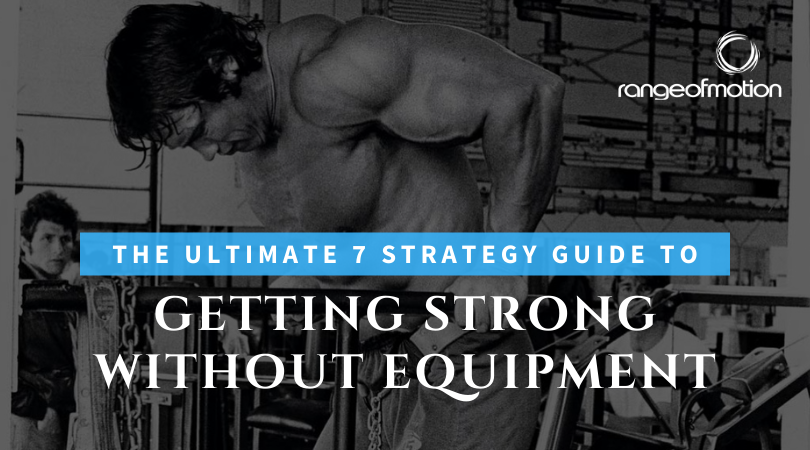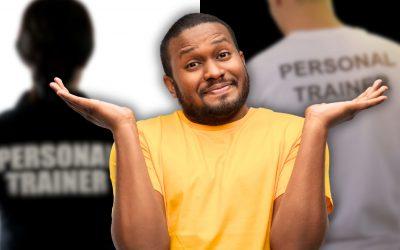Now, you don’t actually need to know these terms to take advantage of them, but with a small handful of science-based exercise techniques, we can use these rules to get strong.
The thing is, these rules are blind to load. What does this mean? It means that it doesn’t matter how much weight is on the bar. It matters how hard it is to lift that weight. Your body responds to the effort it takes you to lift a weight, not the weight itself.
And if you’re unable to access exercise equipment, this is great news. Because it means we can find innovative ways to maintain (and gain) strength that abide by the rules of strength training. You may also be interested in our article “Are You Worried About Your Strength Suffering from COVID-19 Gym Closures?“. If you’re looking for tips on maintain your aerobic fitness without gym access, read “Will I Lose My Fitness During COVID-19 Gym Closures?“.
If you’re looking for our articles on staying fit, strong and healthy through the COVID-19 pandemic, you can find them here.
For our full resource on the exact ‘no equipment’ modifications for a range of commonly performed exercises, go here.
This is the ultimate six step guide to getting strong without equipment.
These are the six techniques (with examples) that you can implement in your exercise program right away – and these techniques will be effective whether you’re someone looking to stay fit and healthy, or a competitive strength athlete.
Strategy 1: Eccentrics.
When you lift weights, there are two main types of contractions your muscles can do. There are ‘concentric’ or ‘shortening’ contractions, where you are lifting a weight, and there are ‘eccentric’ or ‘lengthening’ contractions, where you a lower a weight.
Do a bicep curl. Now lower the weight slowly, fighting gravity as you do. That’s an eccentric contraction. Do a squat, but do the lowering part really slowly. That’s a slow eccentric, and working hard in the eccentric portion of a lift can make you really strong.
To make use of this strategy, simply do slow, five second lowers for any exercises you might be doing. Want to get the strength benefits of bench press? Do a slow five second push-up or dip lower. Want to improve your squat but only have a small selection of weight? Slow down the ‘lowering’ phase. This is called ‘Eccentric Tempo Training’.
Eccentric training has wide reaching benefits to your health and body composition – with the benefits even broader than standard resistance training – so you may actually get more benefits than your usual exercise program.
The research is virtually unanimous in heaping praise on ‘eccentric’ training (sometimes called ‘negatives’). This style of training shows strength gains in excess of 10% over traditional methods, and results in great hypertrophy (muscle growth).
Not only are we able to generate more force after eccentric training, but we are also able to generate it over a greater variance in muscle lengths. Effectively, what this does is to make us stronger over a greater range of motion, increasing our muscles’ torque generating ability. Therefore, less sticking points, less failures on heavy lifts.
Some of our favourite eccentric movements include:
- Nordic hamstring lower knee angle fixed
- Single leg Nordic hamstring lower knee angle fixed
- Single leg Nordic hamstring lower hip angle fixed
- Nordic hamstring lower hip angle fixed
- Partner assisted eccentric trap bar deadlift
- Partner assisted eccentric back squat
- Partner assisted eccentric front squat
- Partner assisted eccentric bench pull
- Partner assisted eccentric strict press
- Partner assisted eccentric bench press
- Partner assisted eccentric deadlift
Not all of these use no equipment, but they will give you some ideas of ways to use this training strategy to build strength.
Learn more about eccentric training in our article ‘Why Your Tempo Squats Aren’t Working‘.
Strategy 2: Paused Repetitions.
Related to ‘Eccentric Tempo Training’ is the use of pauses. Do a squat, but instead of lowering into the squat, then standing straight back up, try pausing for three seconds at the bottom. You may notice it’s harder to stand up when you add the pause.
This is due to the ‘eccentric-concentric movement pattern’. To understand this, you need a basic knowledge of neuromuscular biomechanics.
We’ve already spoken about eccentric contractions. During this ‘lengthening’ contraction, your muscles and tendons store energy. This can then be used in the concentric (or lifting) phase. Think of a rubber band being flicked across the room. If you pull back on the rubber band and release it straight away it will fly further than if you pull back on it, pause, then release it.
This explains why hand release push-ups (taking your hands off the ground at the bottom of a push-up) are so much harder than the regular kind, and ‘touch and go’ deadlifts are easier than re-gripping every rep.
So if you pause at the bottom of a squat, it actually makes you ‘less strong’ in that lift. But remember, we actually want to make the lift harder, because a harder lift will stress your muscles more, and will therefore cause you to develop more strength.
Time is a big factor here. You lose 50% of the stored energy every second. So if you stop at the bottom of a hand release push-up for one second, you lose half the stored energy. Stopping for four seconds will result in all the stored energy being lost.
So how can you apply this to your ‘no equipment’ training? Add in a pause for four seconds at the end of each eccentric ‘lowering’ phase.
Strategy 3: Static Holds.
Isometric training is a style of exercise that involves holding a static position (as opposed to concentric training, where the muscle goes through a ‘shortening contraction’ or eccentric training, where the muscle goes through a ‘lengthening contraction’.
There are a range of benefits of isometric training that are unique to this style of muscle contraction type.
Due to the progressive fatigue from isometric training, you will experience a very high level of recruitment of motor units (motor neuron plus muscle fibre), leading to a very high percentage of total muscle fibres trained.
The exercises in this session also target what is often a weaker part of the movement. Even though the holds are static, this ‘weak point training’ can improve the overall strength of the full movement by strengthening the weakest part. The research points to increases in strength up to 15 degrees on each side of the training angle.
The static holds will improve joint stability to increase the ability to efficiently move loads.
Isometric training has been shown to have the most powerful effect on reducing systolic blood pressure, diastolic blood pressure, and mean arterial pressure.
The session will improve body control and awareness due to the ability to make slight adjustments to body shape to achieve an optimal position. This will have positive effects on postural awareness and control.
In terms of benefits to the joints, the static holds will improve joint stability which can reduce pain, and the lack of movement means that this is an effective training type for people who need to strengthen joints but for whom movement aggravates joint pain. Isometric work is not only effective as a way to exercise to avoid pain, but has also been shown to reduce pain levels.
Some examples of where to use static holds:
- Bottom of push up hold
- Bottom of ring dip hold
- Bottom of ring push up hold
- Chest to bar body row hold
- Chin over bar hold
- Chin over ring hold
- Chin over rings L hang
- Ring dip support hold
- L Sit
Strategy 4: Increasing Movement Speed.
We know that slowing down your movement will give benefits because of the advantages of eccentric training, so it may surprise you to know that speeding up your movements may do the same. Though this time, we’re using this as a strategy to increase power.
Power isn’t just about lifting a heavy weight, it’s about lifting a heavy weight quickly. Lifting 30kg over your head slowly involves less power than lifting that same weight quickly. Lifting quickly will increase your power.
The heavier the weight is that you’re lifting, the slower you move, and the less power you’re able to produce.
Research has shown that maximum power occurs at somewhere between 30% and 65% of your own rep max.
So even if you’re lacking weights, you can still develop power (in fact, you can develop more power) by reducing the weight, and ramping up the movement speed.
Not only can this power be developed by moving faster, but the increased movement speed can also train a portion of your movement that is normally neglected.
Let’s use the example of a squat.
Normally, when squatting a heavy weight, you’ll get to a point (usually about two thirds of the way to standing up) where the rep becomes easy. You know you’ve basically completed the lift, and you rely on momentum to carry you through the final third of the lift.
This results in your muscles not being as strong in the top part of the lift.
With increased speed however, we can continue to accelerate through this (usually neglected) range – to the point that a squat becomes a jump squat. And with that acceleration comes further benefits to your power, in a range that is normally neglected with heavy weights.
Examples of exercises where you’re exploding through this ‘end of range’ include jump squats, jump lunges, dumbbell jump lunges, banded jumping trap bar deadlifts and banded jumping high bar back squats.
Training speed with lower weights will mean when you are able to get back to lifting heavy, you’ll be able to move faster – and the faster you lift, the heavier you lift.
So how can the strategy of increasing movement speed be used to increase your power with limited access to equipment. Reduce the weight and move faster – so fast that you’re able to explode beyond your normal range of motion to get benefits you may not normally get in your regular exercise routine.
Some of our favourite ‘no equipment’ speed, power and plyometric drills include:
- Broad jumps.
- Depth jump into broad jump.
- Depth jump into max vertical leap
- Lateral high hurdle jumps
- Lateral skater jumps
Strategy 5: Unilateral Training.
Many of the movements we traditionally use for strength development use two limbs simultaneously.
We bench press with two arms. We squat with two legs. Even bodyweight movements – two arm push-ups and pull-ups.
An easy way to effectively double the load being placed on your body is to half the number of limbs being used. Without going into the exact physics of this, halving the number of limbs basically doubles the weight that limb is lifting. Push-ups or bench press too easy? Do single arm push-ups. Only got a light kettlebell and want to squat heavy? Do single leg weighted squats (weighted pistols). The variations are almost endless.
And of course, you get the added benefits of increasing your stability (the ability of small muscles to keep joints in optimal position), and balancing out and strength imbalances you may have between the two sides of your body.
If you want to experiment with some unilateral exercises, take a look at:
- Pistol
- Dumbbell jump lunges
- Rear foot elevated split squat
- Tempo front foot elevated back rack lunges
- Single leg hip thrusts
- Single leg good mornings (preferably banded)
- Single leg Nordic hamstring lower knee angle fixed
- Single leg Nordic hamstring lower hip angle fixed
- Single leg, rear foot elevated stiff leg deadlift
Strategy 6: Increasing Range of Motion.
To get stronger, we need to do more work. And there’s actually a mathematical equation for ‘work’.
Work = force x distance.
Here we’re concerned with the ‘distance’ part of this equation. If you move a weight further you do more work. And more work means more benefit and more strength.
Look at the exercises in your program. Can you increase the range of motion for any of them? Can you squat lower? Can you do deeper squats? Can you do strict chest to bar pull-ups instead of just ‘chin over bar’. Can you do parallette push-ups or deficit handstand push-ups?
Whether the weight is a kettlebell/dumbbell/barbell or your body, if you can move it further it will be harder. If it’s harder, you’ll get stronger.
Strategy 7: Changing Lever Length.
Our final strategy is changing lever length (Credit to Dan Meaden from Mobius Health and Performance for inspiring this strategy).
Hold a light weight by your side. Nows hold it out in front of you, with a straight arm. Same weight, very different difficulty. Why the difference? Because the weight is further away (horizontally) from the ‘pivot point’ (technically speaking, there’s a greater ‘radius’).
If you can modify your movements to create a longer ‘lever’ you’ll develop more strength as a result.
Take the example of a dumbbell deadlift. Because the weight stays close to your hips, it’s a very efficient movement. But to increase the effect a light weight has, we don’t want to be efficient. We want to find a way to make it more difficult, to get more benefit. By moving the same dumbbell onto the shoulders, and completing the same movement (which now becomes a ‘good morning’) we can train more strength without having access to heavier weights.
There are numerous bodyweight movements that can give us the same benefits. ‘Straight arm strength’ movements like front lever pulls and back lever pulls are great ‘longer lever’ replacements for pull-ups and dips respectively. Iron crosses, planches, and archer pull-ups and push-ups are other great examples.
We’ve created some free five minute programs for some of these ‘long lever’ movements:
- Front Lever Exercise Improvement Program
- Iron Cross Exercise Improvement Program
- Back Lever Exercise Improvement Program
- Planche Exercise Improvement Program
Combining Strategies:
Of course, we can also combine these strategies in as many combinations as your imagination will allow. Combine eccentric training with unilateral training to do eccentric single leg squats. Paused repetitions and increased range of motion may give you paused, deficit, strict handstand push-ups. Combine changing lever length and increased movement speed to give you jumping good mornings.
The common theme? These are strategies to make your repetitions harder without the need to add weight. Harder reps equals more demand on the muscle. More demand equals an increased need for muscle adaptation. More adaptation equals more strength.





